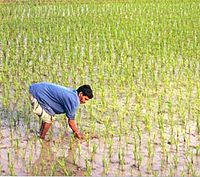
Photo from wikipedia
Abstract Soil infiltration is an inevitable process of the mutual transformation of surface water and groundwater in the ecological hydrologic cycle that helps to transport nutrients required by plants to… Click to show full abstract
Abstract Soil infiltration is an inevitable process of the mutual transformation of surface water and groundwater in the ecological hydrologic cycle that helps to transport nutrients required by plants to the root system, thus promoting vegetation growth and maintaining ecological stability. It is of utmost importance to simulate the process of soil infiltration and calculate the key parameters of soil water migration accurately. Yet, a scale effect in the determination of soil infiltration can seldom be avoided. Based on the scale effect law caused by a change in the inner-ring diameter of the double-ring infiltrometer and common infiltration models, empirical models of soil infiltration scale transfer (SIST) are proposed and established to improve the simulation accuracy of the steady infiltration rate, while reducing test difficulty and consumption. The results show that the four SIST models established based on the infiltration models well simulate the infiltration process of five different sizes of double-ring infiltrometers. The simulation Adj-R2 of the three infiltration zones in the study area was between 0.66 and 0.95, and the validation Adj-R2 ranged from 0.72 to 0.94, indicating that the SIST models showed good applicability in the investigated semi-arid grassland. The results further showed that the double-ring infiltrometer with an inner-ring diameter larger than 90 cm and an outer ring buffer coefficient of 0.33 was not accompanied by the scale effect during measurement. Moreover, the SIST models were used to predict the steady infiltration rate in the study area, providing an accurate data basis for the establishment of regional eco-hydrological models.
Journal Title: Ecological Engineering
Year Published: 2020
Link to full text (if available)
Share on Social Media: Sign Up to like & get
recommendations!